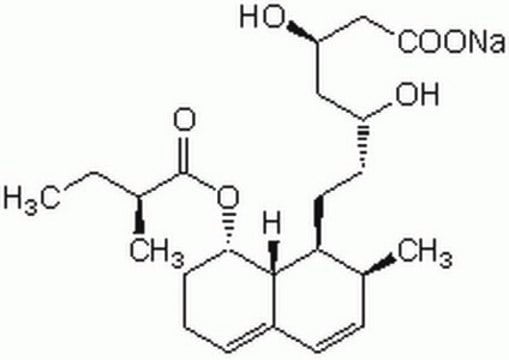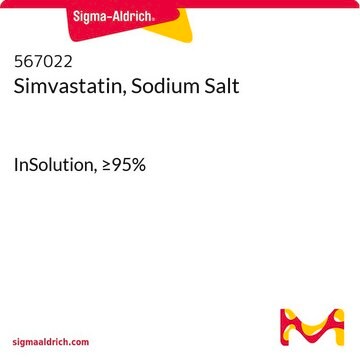438185
Lovastatin
Lovastatin, CAS 75330-75-5, is an anti-hypercholesterolemic agent that inhibits the activity of 3-hydroxy-3-methylglutaryl coenzyme A (HMG-CoA) reductase.
Synonym(s):
Lovastatin, Mevinolin, MK-803, L-Type Calcium Channel Blocker IV
About This Item
Recommended Products
Quality Level
Assay
≥95% (HPLC)
form
powder
manufacturer/tradename
Calbiochem®
storage condition
OK to freeze
protect from light
color
white to off-white
solubility
ethanol: 25 mg/mL
DMSO: 50 mg/mL
shipped in
ambient
storage temp.
2-8°C
InChI
1S/C24H36O5/c1-5-15(3)24(27)29-21-11-14(2)10-17-7-6-16(4)20(23(17)21)9-8-19-12-18(25)13-22(26)28-19/h6-7,10,14-16,18-21,23,25H,5,8-9,11-13H2,1-4H3/t14-,15-,16-,18+,19+,20-,21-,23-/m0/s1
InChI key
PCZOHLXUXFIOCF-BXMDZJJMSA-N
General description
Biochem/physiol Actions
Activity of 3-hydroxy-3-methylglutaryl coenzyme A (HMG-CoA) reductase
Warning
Reconstitution
Other Notes
Carel, K., et al. 1996. J. Biol. Chem.271, 30625.
McGuire, T.F., et al. 1996. J. Biol. Chem. 271, 27402.
Umetani, N., et al. 1996. Biochim. Biophys. Acta1303, 199.
Xu, X.Q., et al. 1996. Arch. Biochem. Biophys. 326, 233.
Reusch, J.E.-B., et al. 1995. J. Biol. Chem.270, 2036.
Jakobisiak, M., et al. 1991. Proc. Natl. Acad.Sci. USA88, 3628.
Keyomarsi, K., et al. 1991. Cancer Res.51, 3602.
Mendola, C.E., and Backer, J.M. 1990. Cell Growth Differ. 1, 499.
Legal Information
Signal Word
Warning
Hazard Statements
Precautionary Statements
Hazard Classifications
Carc. 2 - Repr. 2
Storage Class Code
11 - Combustible Solids
WGK
WGK 3
Flash Point(F)
Not applicable
Flash Point(C)
Not applicable
Certificates of Analysis (COA)
Search for Certificates of Analysis (COA) by entering the products Lot/Batch Number. Lot and Batch Numbers can be found on a product’s label following the words ‘Lot’ or ‘Batch’.
Already Own This Product?
Find documentation for the products that you have recently purchased in the Document Library.
Customers Also Viewed
Articles
Discover critical characteristics to consider when working with enzyme inhibitors, such as cell permeability, the prozone effect, and Lipinski’s rule of 5.
Discover critical characteristics to consider when working with enzyme inhibitors, such as cell permeability, the prozone effect, and Lipinski’s rule of 5.
Discover critical characteristics to consider when working with enzyme inhibitors, such as cell permeability, the prozone effect, and Lipinski’s rule of 5.
Discover critical characteristics to consider when working with enzyme inhibitors, such as cell permeability, the prozone effect, and Lipinski’s rule of 5.
Our team of scientists has experience in all areas of research including Life Science, Material Science, Chemical Synthesis, Chromatography, Analytical and many others.
Contact Technical Service















